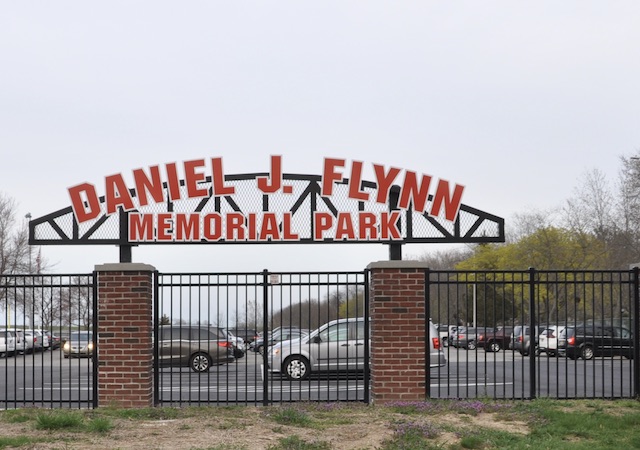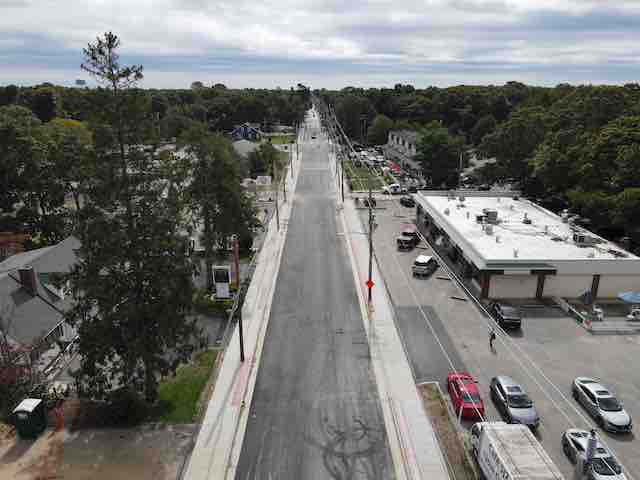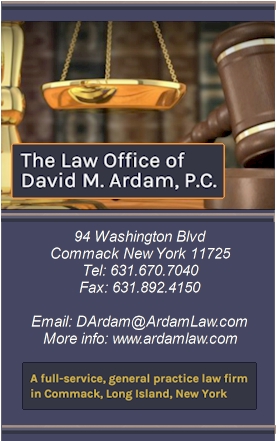News Of Long Ago - "James Clinch Smith Inherits the Homestead Of Judge John Lawrence Smith..."
 Tuesday, October 15, 2013 at 11:56PM
Tuesday, October 15, 2013 at 11:56PM News of Long Ago by Bradley Harris, Smithtown Historian
(Last week’s article was about Judge John Lawrence Smith’s residence in Smithtown Branch and the alterations he made in the old Blydenburgh homestead after purchasing it in 1850. He transformed a large colonial home into an impressive residence that was worthy of the Surrogate Judge of Suffolk County and a Smith family patriarch. This article focuses on the Judge’s family and on James Clinch Smith, the heir who inherited the property when the Judge died in 1889.)
“James Clinch Smith inherits the Homestead of Judge John Lawrence Smith….”
James Clinch Smith was the sixth child of Judge John Lawrence Smith and his wife Sarah Nicoll (Clinch) Smith. James was born in the Smith family Homestead on Middle Country Road in Smithtown Branch on April 3rd, 1856. When he was born, James already had five older siblings – four sisters and a brother. Following his birth, the Smiths had five more children – four more girls and another boy. That meant that James was right in the middle of a very large family, a position that must have been very comforting.
Although the Smiths had a total of eleven children, they lost two of their babies, Alexander Townley Stewart and Anne Alexandrine, shortly after their birth. Bessie, their tenth child remembers growing up in the house on Middle Country Road with eight brothers and sisters. Bessie, tells us in her Memories that her “father and mother and nine children used to sit around the old mahogany dining-room table” in the Homestead. Since Bessie was the youngest, she “always had the high chair” which had been built especially for Bessie, and she “sat at the left” of her mother. “My sisters and brothers were – Nellie, Louise, Larry, Kate, May, Jim, Ella, Charlotte and myself.” (Bessie Springs Smith White, Memories, written May 1926, original manuscript on file in the Smithtown Historical Society archives.) When Bessie was two and a half years old, her sister Charlotte died at the age of six. And when she was five, her sister May died from Spinal Meningitis. That left seven children, five girls and two boys.
Still the Homestead, big as it is, was always full of children. In Memories Bessie writes that as a little girl, she used to sleep with her sister Charlotte, and then when Charlotte died, she slept with Ella in a trundle bed that “was covered up and rolled underneath ‘Nannie’s’ bed during the day.” So the Smith girls shared rooms and no doubt the Smith boys, James and Lawrence, doubled up in another room of the Homestead. There were other people living in the house as well. Bessie mentions an “old Scotch nurse, Cecilia Thompson,” an Irish cook named “Lizzie Rowan, and an old darkie servant, Mary, who did all the rest of the work in the house.” According to Bessie, “Mary was a descendant of one of the old slaves and of course her name was Smith. She had come to our door one winter’s night with her babies in her arms, saying she had been turned out in the snow – of course my mother ‘took her in’ and they occupied the ‘darkie quarters’ – three rooms at the farm end of the house.” Mary was a devoted servant “and brought us all up – and we took care of her until she died at the age of 98.” So the Homestead must have always been a busy, crowded home. (Bessie Springs Smith White, Memories, op. cit.)
Bessie remembers attending school in the “district school,” the little old one-room schoolhouse, the Walt Whitman School, that now sits on Singer Lane. “Jim, Ella, and I were treated just like all the other girls and boys of the village were – used to have our knuckles rapped with a ruler when we were inattentive, and we had to take our turn at sweeping out and dusting the school room ‘after hours.’ When James turned 14 in 1870, his father decided to send him away to “General Russell’s Military School in New Haven.” This decision may have been triggered by what happened to his older brother Lawrence in April of 1870. (Bessie Springs Smith, Memories, op. cit.)
Lawrence was enrolled as a cadet at West Point in the Class of 1873. Bessie remembered “there was great rejoicing when Larry came home, at intervals, in his lovely blue-gray uniform and gold buttons. He used to carry me all over the farm on his shoulder.” Lawrence was on his way home from West Point in the spring of 1870 when he became ill with dysentery. His illness progressed so rapidly that he died on the way to his grandfather’s home in New York City. Lawrence’s sudden death must have been a terrible shock. James was now the Judge’s only surviving son, the Judge’s heir, and the Judge wanted to have him follow in his brother’s footsteps. With Lawrence’s death, James was now surrounded by women – three older sisters who bossed him around, and two younger sisters who idolized their older brother. This was the nurturing environment in the Homestead when James broke free and left home for private school. (Bessie Springs Smith White, Memories, op. cit.)
James went to military school. Two years later he attended the Anthon Grammar School in New York, and after that he enrolled in the Columbia School of Mines. Perhaps he toyed with the idea of becoming an engineer. But at some point he decided to become a lawyer, because in 1878, at the age of 22, “he graduated from Columbia Law School.” For a few years he practiced law with his father in Smithtown and then he became a partner in the firm of Smith and Keene with an office in the old A.T. Stewart building at Broadway and Chambers Street in New York City.
In 1888, as a young man of 32, James Clinch Smith made an interesting investment – he purchased the St. James Driving Park, a fifty-acre parcel of land with a one mile race track on the northwest corner of Edgewood Avenue and Fifty Acre Road. Apparently his position as a partner in the law firm of Smith and Keene gave him the wherewithal, the $6,500 that he paid in 1888, when he purchased the property. After purchasing the property, he leased the property to Robert L. Davis, a professional driver and trainer who managed a track in Port Jefferson. Davis immediately made some improvements to the property, built a new barn and training stables, and restored the one-mile racing track. He reopened the track for trotting races in the summer of 1889 and immediately began to attract horse-racing enthusiasts.
This property was an interesting investment for a young lawyer living in New York City to make at this time in his life. James Clinch Smith was just beginning his career, just getting started in life, and he couldn’t have had a lot of money when he purchased the park. So why did he purchase this driving park? James Clinch Smith loved horses and he loved to race them. He was an avid sportsman and owning the driving park ensured that he would have a place to race his horses. Apparently he owned two fast running horses – Melody and Wild Cat – that he stabled with Mr. Davis at the track and he would race them on the one-mile track whenever he came out to visit his parents at the Homestead.
Although he didn’t have much money in 1888, his financial status rapidly changed when his father died at 73 in March of 1889. James Clinch inherited his father’s home and 250 acres of land on Middle Country Road in Smithtown Branch. A year later in April of 1890, his mother died, and her estate that included the millions of dollars she inherited from Alexander Turney Stewart’s widow, was left to James and his five sisters. Suddenly at the age of 33, James Clinch Smith was a very wealthy man who never had to work another day in his life, and he became one of New York’s most eligible bachelors. He was invited everywhere – summer visits to Newport, sailing on yachts, polo matches, horse races, hunting parties, and social affairs at the homes of New York’s leading families.
The Homestead in Smithtown was still his home but became the center of a hunting and horse-racing crowd of which James Clinch Smith was the acknowledged leader. James owned the finest stable of polo ponies, the fleetest running horses and trotters, and owned the finest racetrack in Suffolk County. He now had the time and the money to pursue his interest in sports. Since he loved horses and enjoyed competing, he was constantly participating in races, horse shows, and polo matches. It was said that he had the largest collection of silver trophies in the State and that he displayed many of them in the billiard room of the Homestead. He became a popular member of New York and Newport society and was one of Mrs. Astor’s privileged 400. He was invited to join a number of prominent New York Clubs of the day and became a member of the Metropolitan, Country, Michaux, Meadow Brook, Hunt, Calumet, Riding, Union, New York Yacht, Larchmont, Seawhanaka, and Corinthian Clubs.
With his active social life, it wasn’t long before a beautiful young heiress from Chicago, named Bertha Ludington Barnes, snagged James Clinch Smith. Not surprisingly, Bertha and James met while riding bicycles on an outing with the Michaux Bicycle Club of New York. James and his sister Bessie joined this fashionable club in 1894, a club that included the Astors and Vanderbilts in its ranks. When Bertha and James met, James was 39 and he was smitten by the young 24 year old beauty from Chicago. Bertha was described by one reporter as being tall and stately, fair, with a wealth of light brown hair, and she was very “chic.” She was said to be an excellent linguist and a gifted musician. She swept him off his feet because two months later they were engaged, and in June of 1895, they were married at a lavish wedding at Grace Church in Chicago, attended by 2,500 people including most of Chicago’s leading citizens. The reception was held at the Barnes’ home, although I don’t think 2,500 people were invited, and then the happy couple was off on their honeymoon.
More about Bertha and James Clinch Smith next month….






Reader Comments